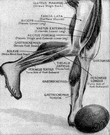sar·to·ri·us
(sär-tôr′ē-əs)n. pl. sar·to·ri·i (-tôr′ē-ī)
A flat narrow thigh muscle, the longest of the human anatomy, crossing the front of the thigh obliquely from the hip to the inner side of the tibia.
[New Latin, from Late Latin sartor, tailor (from its producing the cross-legged position of a tailor at work), from sartus, past participle of sarcīre, to mend.]
American Heritage® Dictionary of the English Language, Fifth Edition. Copyright © 2016 by Houghton Mifflin Harcourt Publishing Company. Published by Houghton Mifflin Harcourt Publishing Company. All rights reserved.
sartorius
(sɑːˈtɔːrɪəs)n, pl -torii (-ˈtɔːrɪˌaɪ)
(Anatomy) anatomy a long ribbon-shaped muscle that aids in flexing the knee
[C18: New Latin, from sartorius musculus, literally: tailor's muscle, because it is used when one sits in the cross-legged position in which tailors traditionally sat while sewing]
Collins English Dictionary – Complete and Unabridged, 12th Edition 2014 © HarperCollins Publishers 1991, 1994, 1998, 2000, 2003, 2006, 2007, 2009, 2011, 2014
sar•to•ri•us
(sɑrˈtɔr i əs, -ˈtoʊr-)n., pl. -to•ri•i (-ˈtɔr iˌaɪ, -ˈtoʊr-)
a long, flat, narrow muscle extending obliquely from the front of the hip to the inner side of the tibia.
[1695–1705; < New Latin sartōrius]
Random House Kernerman Webster's College Dictionary, © 2010 K Dictionaries Ltd. Copyright 2005, 1997, 1991 by Random House, Inc. All rights reserved.
ThesaurusAntonymsRelated WordsSynonymsLegend:
| Noun | 1. |  sartorius - a muscle in the thigh that helps to rotate the leg into the sitting position assumed by a tailor; the longest muscle in the human body sartorius - a muscle in the thigh that helps to rotate the leg into the sitting position assumed by a tailor; the longest muscle in the human bodyskeletal muscle, striated muscle - a muscle that is connected at either or both ends to a bone and so move parts of the skeleton; a muscle that is characterized by transverse stripes |
Based on WordNet 3.0, Farlex clipart collection. © 2003-2012 Princeton University, Farlex Inc.